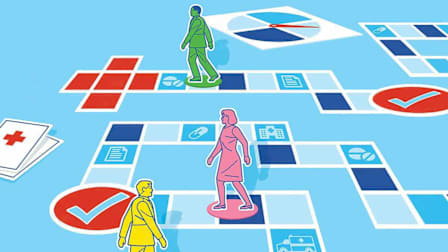How to Get Stronger as You Age
These easy daily moves can help you build more muscle

Muscle strength declines naturally with time. That loss can make everyday activities more difficult and increase the risk of falling.
The best way to head it off is to strength train—but that doesn’t just mean lifting weights. "Humans have been training their muscles without a weight room for thousands of years," says Katy Bowman, MS, a kinesiologist and movement expert in Sequim, Wash. The choices you make throughout the day—from taking the stairs to getting enough sleep—can also help you stay strong as you age. The key? Stay active.
"You don’t need fancy equipment or long training sessions," says Evelien Van Roie, PhD, assistant professor in healthy aging and geriatric rehabilitation at the Hasselt University in Belgium. "What matters is consistently engaging in exercises that genuinely challenge the muscles."
These Everyday Activities Help
"Instead of approaching strength training as a single bout you do a few times a week, pepper it throughout your day," says Bowman. "Think of it like strength snacks."
Stand up more. "One of the biggest risks to muscles is spending too much time in the La-Z-Boy," says Elizabeth Joy, MD, MPH, who leads the American College of Sports Medicine’s Exercise is Medicine initiative. Muscles shrink and become weaker when they’re not used. Standing when you can activates muscles in your legs, rear, and core.
Eat, Sleep, and Move Right
"A complete lifestyle approach is required to get strong and stay strong," says Beth Frates, MD, an associate professor at Harvard Medical School in Boston and a lifestyle medicine expert.
Eat more. Undereating speeds up muscle loss. "As people get older, they often experience a decrease in appetite," says Joy. "As a result, they aren’t eating enough calories to support their muscle mass." The U.S. Dietary Guidelines recommends 1,600 to 2,200 calories daily for older women and 2,000 to 2,600 for older men.
Get enough protein. "It’s a vital building block for maintaining lean body tissue, like muscle," Joy says. Older adults should aim for 0.45 to 0.59 gram of protein per pound of body weight daily, around 72 to 94 grams for a 160-pound person. Choose plant-based proteins, eggs, fish, and poultry instead of red or processed meats.
Limit alcohol. Drinking regularly has been linked to lower muscle mass.
Prioritize sleep. Nighttime is critical for muscle repair. Poor sleep is linked to increased muscle loss, according to a 2023 study in the journal BMC Public Health. It can disrupt muscle-building hormones and increase inflammation, which can contribute to muscle loss. Plus, "if you feel tired during the day, you’re less likely to be active," says Joy. (Go to our sleep guide for tips.)
Try yoga or swimming. Yoga can help you relax and increase flexibility, but it can also build muscle. "It’s strength, balance, and joint mobility all in the same class," Joy says. Hopping into a pool can be worthwhile, too: Water naturally offers resistance to your muscles when you push through it.
Editor’s Note: A version of this article also appeared in the December 2025 issue of Consumer Reports On Health.




















